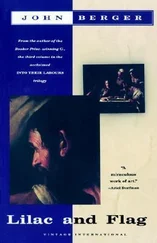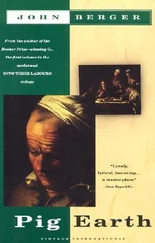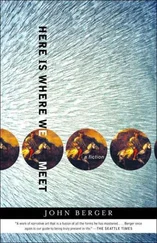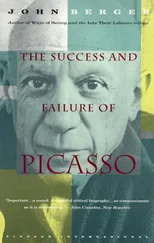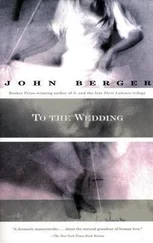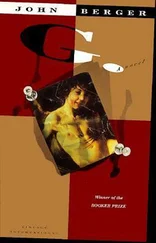This is one of the reasons why Piero’s calculations were not so cold, why — when we notice how the left soldier’s helmet echoes the hill behind him, how the same irregular shield-shape occurs about ten times throughout the painting (count them), or how Christ’s staff marks in ground plan the point of the angle formed by the two lines of trees — why we are not merely fascinated but profoundly moved. Yet it is not the only reason. Piero’s patient and silent calculations went much further than the pure harmonies of design.
Look, for instance, at the overall composition of this work. Its centre, though not of course its true centre, is Christ’s hand, holding his robe as he rises up. The hand furrows the material with emphatic force. This is no casual gesture. It appears to be central to Christ’s whole upward movement out of the tomb. The hand, resting on the knee, also rests on the brow of the first line of hills behind, and the folds of the robe flow down like streams. Downwards. Look now at the soldiers so mundanely, so convincingly asleep. Only the one on the extreme right appears somewhat awkward. His legs, his arm between them, his curved back are understandable. Yet how can he rest like that just on one arm? This apparent awkwardness gives a clue. He looks as though he were lying in an invisible hammock. Strung from where? Suddenly go back to the hand, and now see that all four soldiers lie in an invisible net, trawled by that hand. The emphatic grip makes perfect sense. The four heavy sleeping soldiers are the catch the resurrecting Christ has brought with him from the underworld, from Death. As I said, Piero went far beyond the pure harmonies of design.
There is in all his work an aim behind his calculations. This aim could be summed up in the same way as Henri Poincaré once described the aim of mathematics:
Mathematics is the art of giving the same name to different things.… When language has been well chosen one is astonished to find that all demonstrations made for a known object apply immediately to many new objects.
Piero’s language is visual, not mathematical. It is well chosen because it is based on the selection of superb drawing. Nevertheless, when he connects, by means of composition, a foot with the base of a tree, a foreshortened face with a foreshortened hill, or sleep with death, he does so in order to emphasize their common factors — or, more accurately still, to emphasize the extent to which they are subject to the same physical laws. His special concern with space and perspective is dependent on this aim. The necessity of existing in space is the first common factor. And this is why perspective had so deep a content for Piero. For nearly all his contemporaries it remained a technique of painting.
His ‘ineloquence’, as already hinted, is also connected with the same aim. He paints everything in the same way so that the common laws which govern them may be more easily seen. The correspondences in Piero’s works are endless. He did not have to invent them, he only had to find them. Cloth to flesh, hair to foliage, a finger to a leg, a tent to a womb, men to women, dress to architecture, folds to water — but somehow the list misses the point. Piero is not dealing in metaphors — although the poet in this respect is not so far removed from the scientist: he is dealing in common causes. He explains the world. All the past has led to this moment. And the laws of this convergence are the true content of his art.
Or so it seems. But in fact how could this be possible? A painting is not a treatise. The logic of its measuring is different. Science in the second half of the fifteenth century lacked many concepts and much information which we now find necessary. So how is it that Piero remained convincing, whilst his contemporary astronomers have not?
Look again at Piero’s faces, the ones that watch us. Nothing corresponds to their eyes. Their eyes are separate and unique. It is as though everything around them, the landscape, their own faces, the nose between them, the hair above them, belonged to the explicable, indeed the already explained world: and as though these eyes were looking from the outside through two slits on to this world. And there is our last clue — in the unwavering, speculative eyes of Piero’s watchers. What in fact he is painting is a state of mind. He paints what the world would be like if we could fully explain it, if we could be entirely at one with it. He is the supreme painter of knowledge. As acquired through the methods of science, or — and this makes more sense than seems likely — as acquired through happiness. During the centuries when science was considered the antithesis of art, and art the antithesis of well-being, Piero was ignored. Today we need him again.
1959
At Dulwich Art Gallery there are six Poussin canvases, and I recommend the reader to go there and study them under ideal conditions — it is quiet, the rooms are small and well-lit and one can think without being disturbed. And strange as it may seem, here — not in the endless volumes put out by the Museums of Modern Art — is the clue to all the best works created since Cézanne.
Take a picture like the Nurture of Jupiter. Are we still interested in a child god being suckled by a goat, in bees that made special honey for him and in Cretan nymphs? Hardly. Was even Poussin as interested as is often thought? A nymph, the Virgin Mary, a spectator of David’s triumph over Goliath — each has the same face. So why are we moved? By the purely formal design? If that were so, we would be moved in the same way by, say, a Byzantine mosaic. Clearly we are not. No. In fact, it is here that we come to the first discovery: that in Poussin — and actually, though less obviously, in all art which survives its period — there is something between form and content arbitrarily divided: there is the way of looking at the world, the artist’s method of selection, which the work in its entirety expresses and which is more profound than either its subject matter or its formal organization.
Poussin offers us the world as an impossibly honest trader. Everything on show is declared and defined without the slightest ambiguity. One can see on what every foot stands, what every finger touches. Compare his large tree with the trees in Claude next door. Claude’s are far truer to the confusion of appearances as they normally strike us. In the Poussin the leaves are as defined as those of a book. Yet this clarity is not a question of fussy accuracy. On the contrary Poussin painted broadly and simply — the surface of his painted flesh like that of water running shallowly and imperceptibly over a perfectly smooth pebble. His clarity is the result of order. Nothing in his figure paintings (his late landscapes are different) has been snatched from chaos or temporarily rescued from mystery. The wind blows in the right direction to furl the striding nymph’s golden dress so that it becomes a precise extension and variation on her own movement. The reeds break, and point like arrows to the focal centre of the scene. The sitting nymph’s foot forms a perfect ten-toed fan with the foot of the child.
Yet why, then, is the picture not completely artificial? For two reasons. First, because Poussin’s intensely sensuous vision of the human body forced him — as true sensuousness, as opposed to vicarious eroticism, must always do — to recognize the nature of physical human energy. His figures move with the same inevitability as water finds its own level, and consequently they transcend their rhetorical gestures. A man, after all, lifts his arm to stop a bus in the same way as he might wave to greet the spirit of a poet on Parnassus. And in this painting the kneeling foster-father could be wringing out a wet towel just as well as holding the head of the goat between his legs. Secondly, because the scene, given its arrangement, is still visually true. For example, the deep velvet blue of the sitting nymph’s robe, the pale aquamarine dress of the nymph on the rocks and then the sudden porcelain blue of the sky behind the hills — these blues, in a cereal-coloured landscape, clash, welcome, correspond and set up distances between themselves just as blues can do on Boat Race day.
Читать дальше

